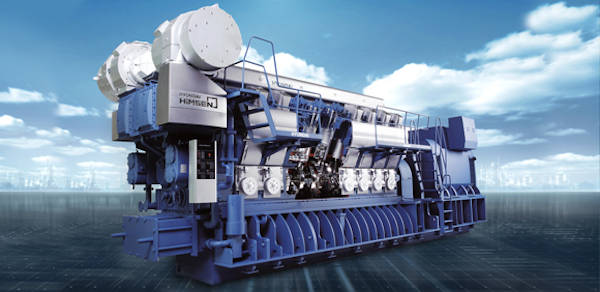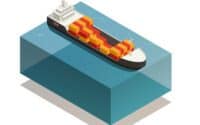Top 10 Fuel Efficient Ship Engines

In the maritime industry, the push for sustainability and efficiency is not just about environmental stewardship—it's also about cutting costs and boosting profitability. Fuel efficiency, in particular, is a pivotal factor in this equation. Modern ship engines have evolved dramatically to meet these demands, combining innovative technologies with meticulous engineering.
From the mighty giants that power vast container ships to the nimble workhorses of smaller vessels, here's a spotlight on ten of the most fuel-efficient ship engines that are making waves in the industry today.
* Please send feedback/suggestions to editor @ shipuniverse.com
| ShipUniverse: Top Maritime Engines | |||||||||||
|---|---|---|---|---|---|---|---|---|---|---|---|
| Engine Name/Model | Manufacturer | Type | Power Output | Fuel Type | Efficiency | Applications | Emissions Compliance | Maintenance Requirements | Cost | Market Popularity | Unique Features |
| MAN B&W 6G60ME-C9.5 | MAN Energy Solutions | Two-Stroke, Diesel | 18,660 kW | HFO/MDO | High, 160 g/kWh | Container Ships, Tankers | IMO Tier II | Moderate, Regular Overhauls | $8-10 million | Widely Used | Integrated Exhaust Gas Recirculation |
| Wärtsilä 31DF | Wärtsilä | Four-Stroke, Dual Fuel | 8,500 kW | LNG/MDO | Very High, 175 g/kWh | Cruise Ships, Ferries | IMO Tier III | Low, Minimal Overhauls | $4-6 million | Highly Popular | Highest Fuel Efficiency in Class |
| Caterpillar 3516E | Caterpillar | Four-Stroke, Diesel | 2,525 kW | MDO | Medium, 190 g/kWh | Offshore Vessels, Tugs | IMO Tier II | Low, Easy Maintenance | $1-2 million | Commonly Used | Compact Design |
| Rolls-Royce MTU 16V4000 M73 | Rolls-Royce | Four-Stroke, Diesel | 3,200 kW | MDO | High, 185 g/kWh | Fast Ferries, Naval Ships | IMO Tier II | Moderate, Routine Inspections | $2-3 million | Widely Trusted | Optimized for High Speed |
| Hyundai HiMSEN H46/60V | Hyundai Heavy Industries | Four-Stroke, Diesel | 13,000 kW | HFO/MDO | High, 170 g/kWh | Bulk Carriers, Tankers | IMO Tier II | Moderate, Regular Maintenance | $7-9 million | Popular in Asia | Advanced Fuel Injection System |
| Sulzer RT-flex96C | WinGD (Winterthur Gas & Diesel) | Two-Stroke, Diesel | 81,420 kW | HFO | Medium, 171 g/kWh | ULCVs (Ultra Large Container Vessels) | IMO Tier II | High, Extensive Maintenance | $36-40 million | Rare but Powerful | World's Most Powerful Engine |
| Mitsubishi UE Engine | Mitsubishi Heavy Industries | Two-Stroke, Diesel | 9,000 kW | HFO | Medium, 180 g/kWh | Tankers, General Cargo Ships | IMO Tier II | Low, Easy to Maintain | $5-7 million | Highly Reliable | Proven Durability |
| MAN 32/44CR | MAN Energy Solutions | Four-Stroke, Diesel | 5,000 kW | MDO | Very High, 165 g/kWh | Cruise Ships, Ferries | IMO Tier III | Low, Minimal Overhauls | $3-4 million | Widely Used | Common Rail Fuel Injection |
| Doosan 12V222TIL | Doosan Engine | Four-Stroke, Diesel | 2,000 kW | MDO | Medium, 185 g/kWh | Tugs, Offshore Vessels | IMO Tier II | Low, Easy to Maintain | $1-2 million | Regionally Popular | Cost-Effective Option |
| Rolls-Royce Bergen B33:45 | Rolls-Royce | Four-Stroke, Diesel | 5,400 kW | MDO | High, 178 g/kWh | Ferries, Offshore Vessels | IMO Tier III | Moderate, Regular Maintenance | $3-5 million | Widely Trusted | Low Emissions |
| Anglo Belgian Corporation DX20 | Anglo Belgian Corporation | Four-Stroke, Diesel | 1,800 kW | MDO | Medium, 180 g/kWh | Tugs, Workboats | IMO Tier III | Low, Easy Maintenance | $1-1.5 million | Niche Usage | Compact and Lightweight |
1. MAN B&W 6G60ME-C9.5
- Pros:
- Fuel Efficiency: The engine is highly fuel-efficient, making it a popular choice for long-haul voyages.
- Durability: Built with robust materials, this engine is designed for longevity, even in demanding marine environments.
- Emissions Compliance: Meets IMO Tier II standards with optional upgrades available for Tier III compliance.
- Advanced Technology: Features an electronic control system for fuel injection timing, optimizing performance and efficiency.
- Cons:
- High Initial Cost: The upfront investment is significant, making it more suitable for larger vessels with high operating budgets.
- Complex Maintenance: The advanced technology requires skilled technicians for maintenance, which can be costly.
- Size and Weight: This engine is large and heavy, which may not be suitable for all types of vessels.
- Insider Tip:
- Optimize Fuel Efficiency: Regularly calibrate the electronic control system that manages fuel injection timing. By fine-tuning the settings, you can achieve even better fuel efficiency, especially during long voyages. Ensure your crew includes technicians trained specifically on this engine to maximize its performance.
2. Wärtsilä 31DF
- Pros:
- Dual-Fuel Capability: Can run on both LNG and Marine Diesel Oil (MDO), providing flexibility in fuel choices and potentially lowering operating costs.
- High Efficiency: Known for having one of the highest fuel efficiencies in its class, reducing overall fuel consumption.
- Emissions Compliance: Meets IMO Tier III standards, making it a future-proof choice for environmentally conscious operators.
- Low Maintenance: The engine is designed for easy maintenance, with extended service intervals that reduce downtime.
- Cons:
- Fuel Infrastructure Dependency: The availability of LNG refueling stations can be a limitation in certain regions.
- Higher LNG Costs: While LNG can be cheaper in some areas, fluctuations in price can make it more expensive than traditional fuels.
- Initial Setup Costs: The dual-fuel system adds complexity and cost to the initial installation.
- Insider Tip:
- Maximize LNG Use: To take full advantage of the engine's dual-fuel capability, plan your routes around LNG refueling stations. Running on LNG as much as possible will not only reduce emissions but also lower fuel costs in the long term, provided that LNG prices remain competitive in your operating regions.
3. Caterpillar 3516E
- Pros:
- Reliability: Caterpillar engines are renowned for their reliability and durability, making the 3516E a solid choice for offshore vessels and tugs.
- Ease of Maintenance: Designed with maintenance in mind, this engine is easy to service, with widely available parts and service support.
- Compact Design: Despite its power, the engine's compact design allows for installation in vessels with limited space.
- Global Support: Caterpillar’s global network ensures that parts and service are readily available, minimizing downtime.
- Cons:
- Fuel Consumption: While reliable, the engine may not be as fuel-efficient as some newer models, leading to higher operational costs over time.
- Noise and Vibration: The engine may produce more noise and vibration compared to more modern, quieter engines.
- Initial Cost: The upfront cost is on the higher side, especially when considering the long-term fuel expenses.
- Insider Tip:
- Regular Maintenance is Key: While this engine is built to last, adhering to a strict maintenance schedule is crucial. Using genuine Caterpillar parts and conducting routine inspections will ensure that the engine performs optimally in demanding environments. For offshore operations, consider investing in noise reduction solutions to mitigate the engine’s noise and vibration.
4. Rolls-Royce MTU 16V4000 M73
- Pros:
- High Power Output: This engine delivers strong power, making it ideal for fast ferries and naval ships that require high speed and rapid acceleration.
- Advanced Technology: Equipped with modern control systems, the engine allows for precise management of performance parameters.
- Compact Design: Despite its power, the engine is relatively compact, which is beneficial for vessels with space constraints.
- Reliability: Rolls-Royce engines are known for their reliability, and the 16V4000 M73 is no exception, offering dependable performance in demanding conditions.
- Cons:
- Fuel Consumption: The engine's high power output comes with relatively high fuel consumption, which can be a concern for long-term operational costs.
- Complex Maintenance: The advanced technology requires specialized knowledge for maintenance, which can increase service costs and downtime.
- Initial Cost: The engine is expensive to purchase, making it more suitable for vessels where performance is prioritized over cost.
- Insider Tip:
- Optimize for Speed: This engine is designed for high-speed operations, so ensure that your vessel's design and operational parameters are aligned with this strength. Regularly update the engine’s software and control systems to maintain peak performance. Consider using fuel additives or adopting advanced fuel management practices to offset the higher fuel consumption.
5. Hyundai HiMSEN H46/60V
- Pros:
- Fuel Efficiency: This engine offers high fuel efficiency, which can significantly reduce operational costs over time.
- Durability: Built for heavy-duty operations, the engine is designed to withstand the rigors of continuous use in large vessels like bulk carriers and tankers.
- Versatility: The engine can operate on both Heavy Fuel Oil (HFO) and Marine Diesel Oil (MDO), providing flexibility in fuel choice.
- Low Emissions: The engine is compliant with IMO Tier II standards, and with modifications, it can meet Tier III standards.
- Cons:
- High Initial Investment: The engine’s upfront cost is high, making it a significant investment for operators.
- Complex Installation: Due to its size and advanced features, the installation process can be more complex and time-consuming compared to smaller, less advanced engines.
- Maintenance Intensity: Regular and thorough maintenance is required to keep the engine operating at peak efficiency, which can be resource-intensive.
- Insider Tip:
- Plan Maintenance Around Operations: To maximize the engine’s lifespan and performance, integrate the maintenance schedule into your vessel’s operational plan. Regularly monitor the engine’s performance data to anticipate and address potential issues before they become serious. Leveraging Hyundai’s global service network can also ensure quick access to parts and expert maintenance.
6. Sulzer RT-flex96C
- Pros:
- Unmatched Power: This engine is the most powerful in the world, capable of powering the largest vessels, such as Ultra Large Container Vessels (ULCVs).
- Fuel Efficiency: Despite its size, the engine is relatively fuel-efficient for the amount of power it produces, which is critical for long-haul voyages.
- Advanced Technology: The engine features a unique common-rail fuel injection system that provides precise control over fuel delivery, improving both efficiency and emissions.
- Durability: Built to endure the harshest marine environments, the engine is designed for long-term reliability and durability.
- Cons:
- Extremely High Cost: The engine’s power and advanced features come at a steep price, both in terms of initial investment and operational costs.
- Complex Maintenance: The size and complexity of the engine require highly skilled personnel for maintenance, which can be expensive and challenging to manage.
- Fuel Dependency: The engine primarily runs on Heavy Fuel Oil (HFO), which, while cost-effective, is subject to price fluctuations and environmental regulations.
- Insider Tip:
- Leverage its Power for Long-Haul Operations: The Sulzer RT-flex96C is best suited for operators who need to move massive amounts of cargo over long distances. To manage costs, negotiate bulk fuel purchase agreements and consider implementing fuel monitoring systems to optimize consumption. Regularly train your engineering crew on the latest maintenance techniques specific to this engine, ensuring that any issues are addressed promptly to avoid costly downtime.
7. Mitsubishi UE Engine
- Pros:
- Proven Reliability: Mitsubishi UE engines have a long history of reliable performance, especially in tankers and general cargo ships.
- Durability: Built with robust materials, this engine is designed to last, withstanding continuous operation over extended periods.
- Fuel Flexibility: The engine operates on Heavy Fuel Oil (HFO), which is cost-effective and widely available.
- Ease of Maintenance: Known for its straightforward design, the engine is relatively easy to maintain, reducing downtime and maintenance costs.
- Cons:
- Fuel Efficiency: While reliable, the engine's fuel efficiency may not be as high as more modern engines, leading to higher operational costs.
- Emissions Compliance: The engine meets IMO Tier II standards, but upgrading to Tier III compliance may require additional investment.
- Outdated Technology: Compared to newer models, the engine lacks some of the advanced features that enhance fuel efficiency and reduce emissions.
- Insider Tip:
- Focus on Preventive Maintenance: The Mitsubishi UE engine is durable, but preventive maintenance is crucial to maintaining its reliability. Regularly inspect and replace wear parts, and consider retrofitting the engine with emissions control technologies if you’re operating in regions with strict environmental regulations. Leveraging Mitsubishi's global service network can also ensure access to genuine parts and expert service.
8. MAN 32/44CR
- Pros:
- High Fuel Efficiency: The common rail fuel injection system enhances fuel efficiency, making this engine a cost-effective choice for cruise ships and ferries.
- Low Emissions: The engine meets IMO Tier III standards, ensuring compliance with current and future environmental regulations.
- Quiet Operation: Designed for passenger vessels, the engine operates quietly, enhancing onboard comfort.
- Advanced Technology: The engine features state-of-the-art technology that optimizes performance and reduces emissions, making it a top choice for environmentally conscious operators.
- Cons:
- Complex Maintenance: The advanced technology requires specialized knowledge for maintenance, which can increase service costs.
- Higher Initial Cost: The upfront investment for this engine is higher compared to simpler, less advanced models.
- Fuel Sensitivity: The engine is optimized for Marine Diesel Oil (MDO), which can be more expensive and less available in certain regions compared to HFO.
- Insider Tip:
- Leverage Common Rail Technology: To maximize the benefits of the common rail fuel injection system, ensure that your crew is well-trained in managing and maintaining this technology. Regularly update the engine's control software to keep it running at peak efficiency. If operating in regions where MDO is costly, consider negotiating bulk fuel contracts to secure better pricing.
9. Doosan 12V222TIL
- Pros:
- Compact and Lightweight: This engine’s compact design is ideal for vessels with limited space, such as tugs and offshore vessels.
- Cost-Effective: The engine offers a balance of performance and cost, making it an attractive option for budget-conscious operators.
- Ease of Maintenance: The engine is designed for easy maintenance, with accessible parts and straightforward servicing procedures.
- Global Support: Doosan has a well-established global support network, ensuring that parts and service are readily available.
- Cons:
- Fuel Efficiency: While reliable, the engine may not be as fuel-efficient as some competitors, potentially leading to higher long-term operational costs.
- Emissions Compliance: The engine meets IMO Tier II standards, but achieving Tier III compliance may require additional upgrades.
- Limited Power Output: The engine’s power output is lower than some competitors, making it less suitable for larger vessels requiring more power.
- Insider Tip:
- Maximize Space Efficiency: The Doosan 12V222TIL is ideal for smaller vessels where space is at a premium. Consider pairing this engine with other compact, efficient systems onboard to optimize the use of available space. For operations in areas with strict emissions regulations, plan ahead for potential upgrades to meet IMO Tier III standards, and leverage Doosan’s support network to keep maintenance costs low.
10. Rolls-Royce Bergen B33:45
- Pros:
- Low Emissions: This engine meets IMO Tier III standards, making it a strong choice for operators focused on environmental compliance.
- Fuel Efficiency: The Bergen B33:45 is designed for high fuel efficiency, helping to reduce operational costs over time.
- Reliability: Known for its robust construction, this engine is built to handle demanding maritime conditions with minimal downtime.
- Quiet Operation: The engine operates with low noise levels, which is particularly beneficial for passenger vessels like ferries.
- Cons:
- Higher Initial Cost: The advanced technology and compliance with strict emissions standards result in a higher upfront cost.
- Maintenance Complexity: The engine’s sophisticated systems require specialized knowledge for maintenance, potentially increasing service costs.
- Fuel Specificity: The engine is optimized for Marine Diesel Oil (MDO), which can be more expensive and less accessible in certain regions.
- Insider Tip:
- Leverage Emissions Compliance: Use the engine's compliance with IMO Tier III standards as a selling point when negotiating charter rates or contracts, especially in environmentally sensitive regions. Regularly update the engine's control systems and software to maintain optimal fuel efficiency and performance. Consider training your crew extensively on the engine’s maintenance requirements to minimize downtime and extend its lifespan.
11. Anglo Belgian Corporation DX20
- Pros:
- Compact and Lightweight: This engine is ideal for smaller vessels like tugs and workboats, where space and weight are critical considerations.
- Cost-Effective: The DX20 offers good performance at a relatively low cost, making it an attractive option for budget-conscious operators.
- Low Maintenance: The engine is designed for ease of maintenance, with straightforward servicing procedures and accessible parts.
- Compliance: The engine meets IMO Tier III standards, ensuring it can be used in regions with stringent emissions regulations.
- Cons:
- Limited Power Output: The engine’s power output may be insufficient for larger or more demanding vessels, limiting its application to smaller ships.
- Fuel Efficiency: While adequate, the engine’s fuel efficiency is not as high as some of the more advanced models on the market, which could lead to higher operational costs over time.
- Market Niche: The engine is popular in specific niches but may not be as widely supported globally as engines from larger manufacturers.
- Insider Tip:
- Optimize for Niche Operations: If you’re operating in a specific niche where this engine is popular, such as small workboats, leverage the engine’s low cost and ease of maintenance to reduce overall operating expenses. Ensure that your crew is trained to perform routine maintenance in-house to avoid costly service contracts. For operators in regions with strict emissions standards, the DX20’s compliance can provide a competitive edge.
12. Makita MK6M35K
- Pros:
- Reliability: The Makita MK6M35K is known for its reliable performance, particularly in general cargo ships and bulk carriers.
- Durability: Built to last, this engine can handle continuous operation over long periods, making it a good fit for demanding maritime environments.
- Fuel Flexibility: The engine can operate on both Heavy Fuel Oil (HFO) and Marine Diesel Oil (MDO), giving operators flexibility in fuel choice based on availability and cost.
- Moderate Maintenance: The engine requires regular maintenance, but it is relatively straightforward, which helps to keep downtime and costs low.
- Cons:
- Fuel Efficiency: While reliable, the engine’s fuel efficiency may not be as high as more modern engines, leading to higher operational costs.
- Emissions Compliance: The engine meets IMO Tier II standards, but upgrading to meet Tier III standards could involve additional costs.
- Technology: Compared to newer engines, the Makita MK6M35K may lack some advanced features that enhance fuel efficiency and reduce emissions.
- Insider Tip:
- Focus on Fuel Management: To manage operational costs, closely monitor fuel consumption and consider implementing fuel-saving practices such as optimizing speed and route planning. Given the engine’s durability, invest in preventive maintenance to extend its lifespan and ensure reliable performance. If operating in regions with stricter emissions regulations, consider retrofitting the engine with emissions control technologies.

Do you have a Maritime Product or Service that may be of interest to Shipowners? Tell us about it here!
Do you have feedback or insights? Please reach out to editor @ shipuniverse.com



